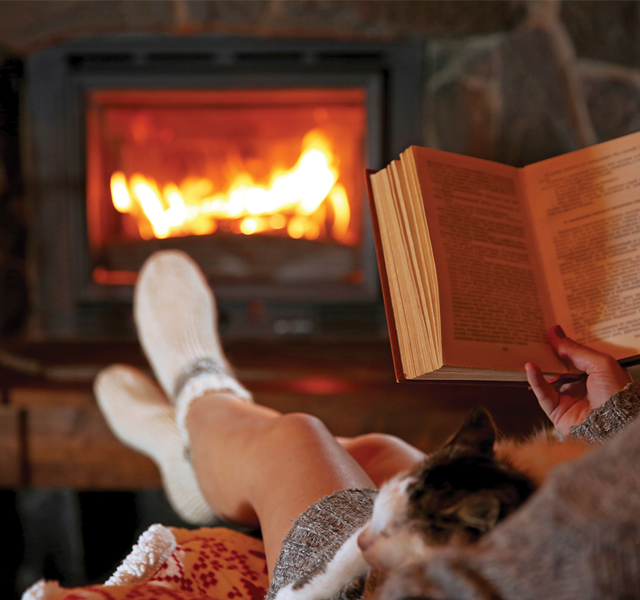The Cardiologist's Wife: Fireplace Safety Tips
The Cardiologist's Wife: Fireplace Safety Tips
There is nothing like relaxing by a warm, crackling fire on a bitter winter evening to lift the spirits and chase away the cold. A fireplace provides extra heat, a cozy gathering place for friends and family, inspires romance and has a calming, even meditative effect. A well-designed fireplace adds value to your home and can serve as a source of heat in a power outage. But, as one Jonesboro family found out this past December, a fireplace can be destructive and even deadly.
One local couple had settled in front of the fire for a cozy evening a couple of weeks before Christmas. Suddenly, a loud rumbling roar erupted from the fireplace. As the homeowner ran outside and looked up at the chimney top, sparks were flying out the top like a fireworks display. The fire department arrived in minutes and firemen were able to put out the fire, but they told the couple they were lucky the fire didn’t blow a hole in the roof. Still, ashes blew out all over the interior of the house and there was some water damage from putting out the fire, so they will have to do extensive remodeling and repair. The couple, of course, is thankful it wasn’t worse and hopes others can avoid a similar situation by learning a few tips.
Those who have a fireplace should know how to operate it safely, how to keep it in good working order and general fireplace safety. Doing so will mean years of trouble-free enjoyment. One of the most important things is to have the chimney checked and cleaned annually by a professional to ensure that it is functioning safely and efficiently. This is true even for gas fireplaces.
Remove excess ashes as needed. Ideally, there should be no more than an inch or less of ashes in the fireplace. A thick layer of ashes restricts air supply to the fire, resulting in more smoke. Place the ashes in a metal container and place outside at least 10 feet from the house.
Make sure the flue or damper is open before starting the fire to draw smoke out of the house. Do not close the damper until the embers have completely stopped burning and are cool. Make sure the fire is completely out before going to bed or leaving the house.
Use a safety screen to prevent sparks, embers or even a log from escaping the fireplace and starting a fire. A screen will also keep pets and children from getting burned. Always supervise children when a fire is burning; do not leave them alone in the same room with the fire. Put fireplace tools, lighters and matches out of reach of children and teach them fireplace safety as early as possible. Keep the area about 3 feet around the fireplace free of clutter or decorative items that could catch fire.
Use dry, well-aged wood as it burns more evenly, longer and hotter. Green or wet wood leads to more smoke and causes more soot build up in the chimney. There are videos online that show how to stack wood properly in the fireplace. You can used crumpled newspaper, small twigs or commercial fire starters for kindling to start the fire. Never, ever use flammable liquids to start a fire. If possible, keeping a window open – even a little bit – will provide extra ventilation.
Install smoke and carbon monoxide detectors in your home. Test them regularly, and change the batteries at least yearly. Make sure you have a working fire extinguisher near the fireplace and that everyone knows how to use it.
While gas fireplaces are easier to use and require somewhat less maintenance, they also need to be cleaned and checked yearly to ensure they are working safely and efficiently. Even the fake logs need regular care and cleaning. Be aware of odors like rotten eggs or carbon monoxide that may indicate a gas leak or other problem within the chimney. Valves and connectors can erode or malfunction in a gas fireplace, something an inspector would find.
Replace the batteries in fireplace remotes twice a year so the fire can be shut down quickly if necessary. Look for signs of excess moisture or cracks in the mortar or paint around the fireplace, as this is a possible source of problems.
When looking for a chimney sweep, check to see that they are certified by a recognized organization like the Chimney Safety Institute of America (CSIA) and that they have insurance coverage. They should be able to give you a detailed inspection process and report on any findings and proposed repairs.
Local chimney sweeps include Chimney Techs, (870) 301-2060, and NEA Chimney Services, (870) 275-1271.
Schedule a chimney inspection and cleaning in the spring or summer to be ready for the next cold season, allowing plenty of time to address any issues. For those who have not had their fireplace cleaned in some time, consider scheduling one right away to make sure there aren’t any problems brewing.







